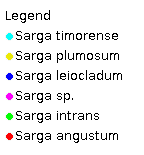Sarga Proc. Roy. Soc. Vict., new series 23: 296 (1911).
Derivation:. Meaning obscure, derivation not given by author, but possibly an allusion to being intermediate between Agrostis and Stipa (H.T.Clifford).
Taxonomic revisions, nomenclatural references:. R.E.Spangler, Aust. Syst. Bot. (in press.).
Key references (keys and floras):. C.A.Gardner, Flora of Western Australia 1 Gramineae 314–320 (1952) as Sorghum; J.W.Vickery, Flora of New South Wales, Gramineae 19: 29–33 (1961) as Sorghum ; E.E.Henty, Manual Grasses New Guinea 173, 176–177 (1969) as Sorghum; M.Lazarides, Tropical Grasses S.E. Asia 72–73 (1980) as Sorghum; M.Lazarides, Flora of Central Australia 491 (1981) as Sorghum; J.C.Tothill and J.B.Hacker, Grasses of Southern Queensland 378–381(1983) as Sorghum; M.Lazarides, F.Quinn and J.Palmer, Flora of the Kimberley Region 1219–1222 (1992) as Sorghum; B.K.Simon, Key to Australian Grasses 155–159 (1993) as Sorghum; S.W.L.Jacobs and K.L.McClay, Flora of New South Wales 4: 435–437 (1993) as Sorghum; N.G.Walsh, Flora of Victoria 2: 619–620 (1994) as Sorghum; D.Sharp and B.K.Simon, AusGrass (2002); S.W.L.Jacobs, R.D.B.Whalley & D.J.B.Wheeler, Grasses of New South Wales, 4th ed, 373 as Sarga (2008)
Native and naturalised. 8 species, from Eastern Africa, Southeast Asia and Australia. 5 species in Australia, WA, NT, Qld, NSW, and Vic. Also Malesia.
Habit. Annual or perennial, tufted. Leaf blades narrow. Ligule an unfringed membrane or a fringed membrane.
Inflorescence. Inflorescence paniculate, an open panicle with branches ending in racemes of paired spikelets, open or contracted.
Spikelets. Spikelets dorsally compressed, 2 flowered, with 1 fertile floret, paired, sessile and pedicelled, in pedicelled/sessile combinations; with rachilla terminating in a floret; sessile spikelet with lower incomplete floret. Fertile spikelets elliptic or lanceolate, dorsally compressed, falling with glumes.
Glumes. Glumes more or less equal, long relative to adjacent lemmas, awnless, dissimilar. Lower glume two-keeled, convex on back to flattened on back, relatively smooth, 5–11 nerved. Upper glume 7–11 nerved.
Florets. Lower incomplete floret(s) sterile. Lemmas awnless, similar in texture to fertile lemmas, not becoming indurated. Fertile florets 1. Lemmas less firm than glumes, not becoming indurated, incised, awned, 1–3 nerved, glabrous. Awns 1, from a sinus, geniculate, hairless, much shorter than body of lemma to much longer than body of lemma. Palea present or absent, 2 nerved or nerveless. Grain small or medium sized. Hilum short. Embryo large. Pedicels free of rachis. Pedicelled spikelets present or absent, similar in shape to sessile spikelet, sterile or male.
Kranz Anatomy. C4, biochemical type NADP-ME.
2n = 10, 20, 30, and 40, 2, 4, 6, and 8 ploid.
Habitat. Mesophytic. Species of open habitats.
Classification. Panicoideae; Andropogoneae.
Notes. A recent split from Sorghum (Spangler, in press).
Types Species. S. stipoidea Ewart & Jean White = S. timorense (Kunth) Spangler.
Biogeographic Element. Clifford & Simon 1981, Simon & Jacobs 1990: Endemic.


